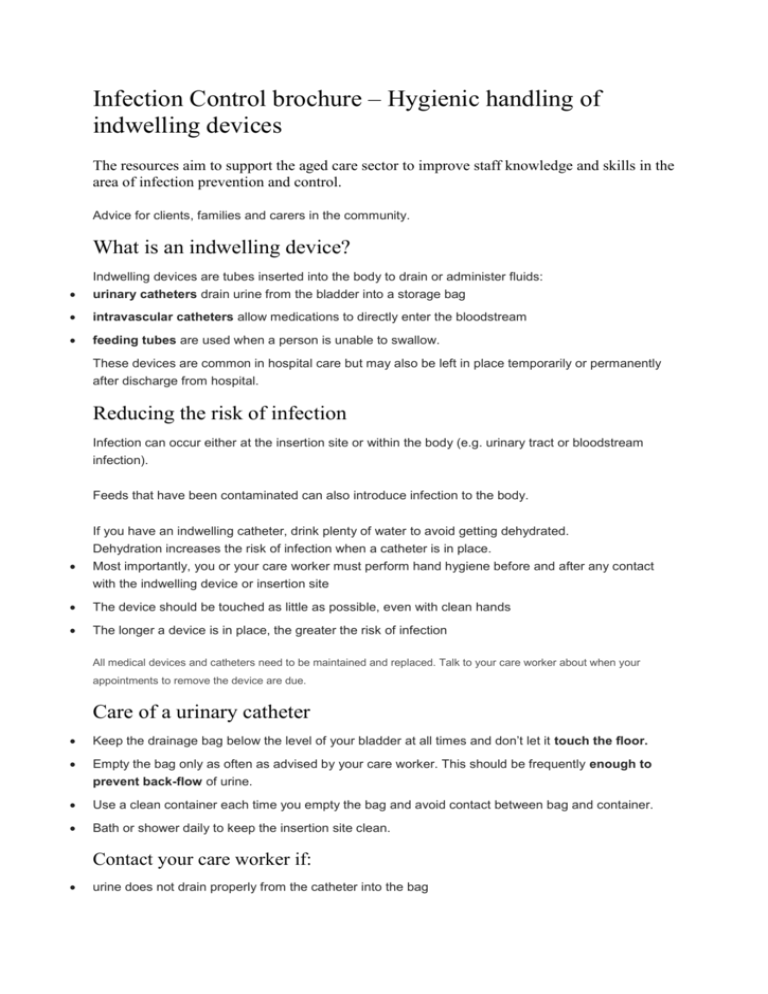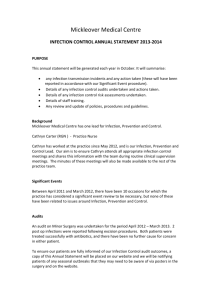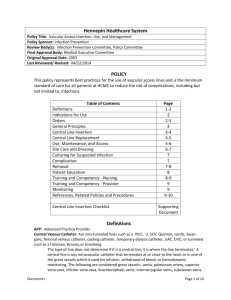Hygienic Handling of Indwelling Devices
advertisement

Infection Control brochure – Hygienic handling of indwelling devices The resources aim to support the aged care sector to improve staff knowledge and skills in the area of infection prevention and control. Advice for clients, families and carers in the community. What is an indwelling device? Indwelling devices are tubes inserted into the body to drain or administer fluids: urinary catheters drain urine from the bladder into a storage bag intravascular catheters allow medications to directly enter the bloodstream feeding tubes are used when a person is unable to swallow. These devices are common in hospital care but may also be left in place temporarily or permanently after discharge from hospital. Reducing the risk of infection Infection can occur either at the insertion site or within the body (e.g. urinary tract or bloodstream infection). Feeds that have been contaminated can also introduce infection to the body. If you have an indwelling catheter, drink plenty of water to avoid getting dehydrated. Dehydration increases the risk of infection when a catheter is in place. Most importantly, you or your care worker must perform hand hygiene before and after any contact with the indwelling device or insertion site The device should be touched as little as possible, even with clean hands The longer a device is in place, the greater the risk of infection All medical devices and catheters need to be maintained and replaced. Talk to your care worker about when your appointments to remove the device are due. Care of a urinary catheter Keep the drainage bag below the level of your bladder at all times and don’t let it touch the floor. Empty the bag only as often as advised by your care worker. This should be frequently enough to prevent back-flow of urine. Use a clean container each time you empty the bag and avoid contact between bag and container. Bath or shower daily to keep the insertion site clean. Contact your care worker if: urine does not drain properly from the catheter into the bag the catheter comes out or is leaking the urine is thick and cloudy, has mucus, red specks, or blood in it, or has a strong (bad) smell you have pain or burning in your urethra, bladder, abdomen or lower back you have shaking chills or a temperature over 38°C the insertion site is red, swollen or painful. Care of a feeding tube and insertion site Wash the insertion site daily with water and dry thoroughly. Flush the feeding tube before and after use (ask your care worker whether to use tap or boiled water). Before preparing a feed, clean the work area and equipment and perform hand hygiene. Prepare feeds as advised by your care worker. Perform hand hygiene again before administering the feed. Touch food and equipment as little as possible throughout the process. Contact your care worker if: the insertion site is red, swollen or painful you have diarrhoea and/or vomiting you have shaking chills or a temperature over 38°C. Care of an intravascular catheter Examine the dressing daily and change it if it is soiled or loose. Routinely change the dressing as advised by your doctor or care worker. Contact your care worker if: the insertion site is red, swollen or painful you have shaking chills or a temperature over 38°C you feel confused or dizzy you have a fast heartbeat and/or breathing. Maintaining hygiene at home If you have an indwelling device or care for someone who has one, there are a number of things you can do to reduce the risk of infection. Perform hand hygiene carefully with soap and water or an alcohol-based hand rub before touching the device. Don’t be afraid to ask your care workers if they have performed hand hygiene. Ask your care worker to explain how to care for your device and how to avoid infections/complications. Avoid unnecessary handling of the device. Try not to have too much clutter in your house. Make sure pets are not in the room during care activities. Call your doctor if you think there is something wrong with the device. More information Don’t hesitate to ask your doctor or care worker for more information. Hand Hygiene Australia (2008) Hand Hygiene Brouchure at: hha.org.au/ForConsumers.aspx References NHMRC (2010) Australian Guidelines for the Prevention and Control of Infection in Healthcare at: nhmrc.gov.au/guidelines/publications/cd33 All information in this publication is correct as at April 2013







